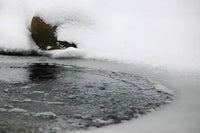Pond Freezing Over
When temperatures drop below freezing, your pond can freeze over. Ice on your pond is not a problem for your fish. However, it stops the exchange of harmful gases and oxygen with the outside air. Therefore, always ensure that there is a hole or opening.
Harmful Gases and Oxygen
Your pond goes into sleep mode in the winter, but processes in the ecosystem remain active. For example, fish still need oxygen and produce CO2. Your pond also continues to produce ammonia, nitrite, and nitrate. When your pond is completely covered with ice, these substances cannot be exchanged with the outside air. Therefore, always make sure there is an opening or hole in your pond.
Keeping a Hole or Opening in the Ice on Your Pond
You can ensure that substance exchange remains between your pond and the outside air in the following ways:
- Waterfall - A waterfall keeps the water moving and provides extra oxygen in your pond
- Fountain - A fountain provides extra aeration and keeps your pond moving
- Aeration Fountain - An aeration fountain, such as the BluFountain, provides powerful aeration of your pond and keeps an opening open for a long time
- Air Pump - An air pump also provides movement and provides extra oxygen directly into the water
- Pond Heater - You can use a heater to keep an opening in your pond. Note that this can lead to high energy costs.
Note: Never chop open a hole
Never chop open a hole. When you use a lot of force to make an opening, this can cause vibrations and noise in your pond. This causes stress to your fish and can be fatal.
Turn Off Fountain and Waterfall in Severe Frost
If it continues to freeze severely for a long time, your fountain or waterfall may eventually freeze over. This can damage the equipment. Keep a close eye on this and switch off the equipment in time. If necessary, remove the equipment from your pond if the instructions indicate this.

